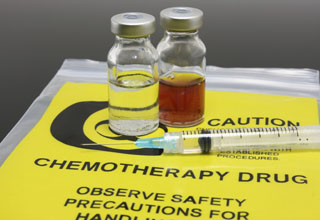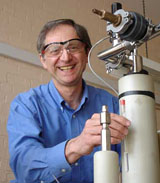Metals in Medicine
Written by Professor Peter Sadler, Department of Chemistry
Published August 2010
The Sadler Research Group in the Department of Chemistry works in the field of medicinal inorganic chemistry – investigating the role of metals in medicine. The Group aims to understand the role that metals play in nature and to try to develop the use of metal-containing compounds as new chemotherapeutic agents. As a result, this research is highly interdisciplinary, at the interface of (inorganic) chemistry, biology and medicine. Below, Professor Sadler describes the Group’s current work, focusing on four topics which explore different approaches to the development of new medicines based on different metals.
 Anticancer Drugs With Platinum: A Photoactivation Strategy
Anticancer Drugs With Platinum: A Photoactivation Strategy
People suffering from cancer are typically treated with either surgery, radiotherapy or chemotherapy. Currently the world's most widely used chemotherapeutic drugs are platinum-based: a leading example is Cisplatin, a compound containing platinum with a 2+ charge. It is generally accepted that the anticancer activity of cisplatin and other closely related platinum compounds arises from their ability to damage DNA in cancer cells, leading to cell death.
The existing platinum drugs are highly toxic to both healthy and cancerous cells in the body. As a result, serious side-effects of treatment are a frequent and serious problem in chemotherapy. These side-effects can be so severe that treatment has to be stopped, leading to treatment failure and ultimately to the death of the patient. In some cases the cancerous cells in the bodies of patients become resistant after repeated doses of the drugs; then the cells are not killed by the drug and the cancer is not cured.
If platinum drugs could be made harmless until they enter the cancer cells... this would greatly reduce unwanted side-effects.
Some of our research is aimed at developing new platinum anticancer drugs which work in a different way to cisplatin. If platinum drugs could be made harmless until they enter the cancer cells, and then be activated only in the tumour tissue, this would greatly reduce unwanted side-effects, allow treatment of cisplatin-resistant tumours, and may also allow treatment of a wider range of cancers. For this purpose, we design compounds containing platinum with a 4+ charge. They are not toxic and must be converted to platinum 2+ compounds before they kill cells. We activate them specifically in cancer cells and not in other normal cells using a directed fine beam of (laser) light. Our encouraging preliminary data suggest that we can make compounds that are more effective than cisplatin itself.
We use computer predictions to help design our new complexes. We are also investigating the development of new light sources for activating our compound in collaboration with researchers in Bath and Erlangen in Germany. This should lead to more controllable activation and perhaps the prospect of reaching internal sites of the human body which are currently inaccessible to light beams.
Anticancer Drugs with Different Metals: Ruthenium and Osmium
While the anticancer activity of platinum containing compounds has been the subject of intensive research worldwide, the medicinal properties of other metals have been relatively little explored. As different metals possess different properties, the study of such compounds by medicinal inorganic chemists holds the promise of new medication that works via different so-called ‘mechanisms of action’, which means that it achieves its ultimate goal, of curing the disease, in different ways. Hence the previously-mentioned drawbacks of current platinum medication could possibly be circumvented.
In our group we are particularly interested in new drugs that contain the metals ruthenium and osmium. We have synthesized a large number of such compounds containing these metals and have given them an ‘organic coat’ (they contain metal-carbon bonds, and are called organometallic compounds) and found that a specific group shows promising activity against a number of different types of cancers. To understand the way in which these potential new anticancer agents work, we are exploring their chemical properties in great detail in our lab and studying their interaction with biomolecules such as DNA and proteins, which are potential targets. The information about structure and activity we get from these studies then serves as feedback and allows us to improve our initial design. This way we hope to develop new drugs that are not only active in the treatment of many different types of cancer, but which are also very selective and have less side-effects for the patient.
Antiviral and Stem-Cell-Mobilising MetalloMacrocycles
The organic drug AMD3100 (Mozobil) has recently been given the title of ‘orphan drug’ by the Food and Drug Administration (FDA), the American body which regulates new drug approval, as it is able to mobilise stem-cells from bone marrow. Harvesting such stem-cells is important for transplantation purposes. The drug has also been in clinical trials as a highly potent and selective anti-HIV agent, but significant side-effects unfortunately led to its withdrawal after Phase II trials.
The very nature of the drug suggests that it will interact with metals in the body and that the metal-bound version of the compound could be the active form. We study the influence of different metals on the structure and activity of the drug and its interaction with the biological target. Insight into this behaviour should allow us to improve the design of this class of drugs further.
This process could provide new insight into how iron is deposited in the brains of patients with some forms of Parkinson’s, Alzheimer’s and Huntington’s diseases.
New Antibiotics: The importance of Iron for infectious bacteria
Many infectious virulent bacteria need to feed on iron to cause a disease. Numerous bacteria have developed specific systems for capturing iron, including our iron, consisting of a dedicated group of iron-binding proteins responsible for iron uptake. In our research, we study iron uptake and release mechanisms, not only for the bacterial iron transport proteins, but also for a very similar protein in our blood that transports and delivers iron to the cells of our own body.
Through this research we hope to design and synthesize new metal compounds as potential antibacterial agents (antibiotics). Such metallo-antibiotics might block iron uptake by pathogenic bacteria, in effect starving them to death. Our related studies on the human protein (serum transferrin) have shown that the mechanism that we rely on to transport iron safely through our blood stream can, in certain circumstances, collapse into a state which grows long worm-like ‘fibrils’ banded by deposits of iron rust. This process could provide new insight into how iron is deposited in the brains of patients with some forms of Parkinson’s, Alzheimer’s and Huntington’s diseases.
 Professor Peter Sadler became Head of Chemistry at the University of Warwick in 2007. Previously he was a PI in RASOR at the University of Edinburgh. While in Edinburgh he was Crum Brown Professor of Chemistry at the University of Edinburgh with over 30 years of experience in protein chemistry. His research interests focus on metals in biology and medicine, the design and mechanism of action of metallodrugs, especially the role of proteins in metal-induced signal transduction. He was the lead applicant of a JIF bid which established the Wellcome Trust Edinburgh Protein Interaction Centre (EPIC) of which he was the Coordinator. He has played a prominent role in EC research activities.
Professor Peter Sadler became Head of Chemistry at the University of Warwick in 2007. Previously he was a PI in RASOR at the University of Edinburgh. While in Edinburgh he was Crum Brown Professor of Chemistry at the University of Edinburgh with over 30 years of experience in protein chemistry. His research interests focus on metals in biology and medicine, the design and mechanism of action of metallodrugs, especially the role of proteins in metal-induced signal transduction. He was the lead applicant of a JIF bid which established the Wellcome Trust Edinburgh Protein Interaction Centre (EPIC) of which he was the Coordinator. He has played a prominent role in EC research activities.
